Best mirrorless camera for professionals
Introduction
It’s 2019, and int seems like all camera manufacturers have jumped on the mirrorless wagon. Sony is still the market leader in the mirrorless segment with the A7 series, but the Canon EOS R, Nikon Z and Panasonic Lumix S1 cameras now offer some serious competition.
In case you’re not totally clear on what a mirrorless camera is, it lacks an internal mirror, you can read all about it here. As a professional photographer interested in mirrorless, I also believe it is best to go for a full frame sensor body. The development of APS-C cameras has halted in the last few years, even Fujifilm is now concentrating on more on the niche medium format maker than on the FX system.
As a professional photographer, is it now time to make the switch from a DSLR to your first mirrorless camera? And if so, which brand should you invest your hard earned cash in? Before getting into this and offering my recommendations for best mirrorless camera for professionals, let’s first take a look at possible reasons why you should switch and (perhaps surprisingly for a site all about mirrorless) some thoughts on why you should stick with your DSLR for now.
Reasons to switch to mirrorless or not
Obviously, mirrorless is the talk of the town for the moment. It’s what’s eating up the entire research and development budget at Sony, Canon, Nikon, Panasonic and even Sigma who’ll join the mirrorless race later this year. This means it’s where you’ll most probably find the most innovative products, features and new lens designs. Due to this fact, the mirrorless camera industry has evolved from a niche market product primarily designed to be small and light into camera systems for 100MP plus sensors, amazingly fast autofocus with features like eye tracking (even with animals) and extremely fast continuous focus.
The only problem is that… we’re not there yet. Let me clarify this statement in the sense that not all camera brands are there yet and of course we don’t have any full frame 100MP cameras yet (though the latest mirrorless lens designs are probably capable of resolving it).
I don’t believe that it makes sense for every photographer to switch brands either just because someone else has the best mirrorless tech. As a professional, your original brand choice was not just about technical specification, you’re also buying into the overal system operation and most importantly the colour science. If you prefer Canon or Nikon skin tones for instance, I don’t think you’ll ever be totally happy with Sony or Panasonic colours. Many sports and press photographers, where speed is of the essence, work with jpegs and don’t have the time to make this work for them.
You should also consider the fact that a switch to mirrorless will be expensive. Yes you’ll get lured in with adapted lenses but you’ll eventually want to go full native because of the added features this will bring.
Best mirrorless camera for professionals: second body
This brings me to my advice for most DSLR shooters debating on switching to mirrorless. As a first step, I would suggest getting a second mirrorless body. I have no doubt in my mind that mirrorless is the future, but your DSLR still has a few good years left. With a second mirrorless body, you can get used to this system without the sometimes steep learning curve associated with a switch like this.
And the good thing is that you’ll be able to stick with your current brand. Both Canon and Nikon have excellent lens adapters that allow you to have near equal performance as native lenses without the added expense of replacing all your DSLR lenses. And they are often included for free when you buy the Canon EOS R, EOS RP, Nikon Z6 or Nikon Z7. If you’re a Sony A-mount shooter, the same applies to you by the way.
This way, you’ll be able to gradually upgrade your lenses over the next few years. I would also suggest going for the latest and lower megapixel models. For Nikon the Z6 and Canon the EOS RP. This Has two reasons, firstly the are cheaper and secondly, mirrorless cameras need a powerful processor because the sensor is used for the viewfinder and autofocus too. We’re at a stage now where a 24 megapixel mirrorless camera has become fast and responsive, but if you go higher than that it’s more difficult for the processor to keep up. This will definitely change in the next few years.
Best mirrorless camera for professionals: Sports
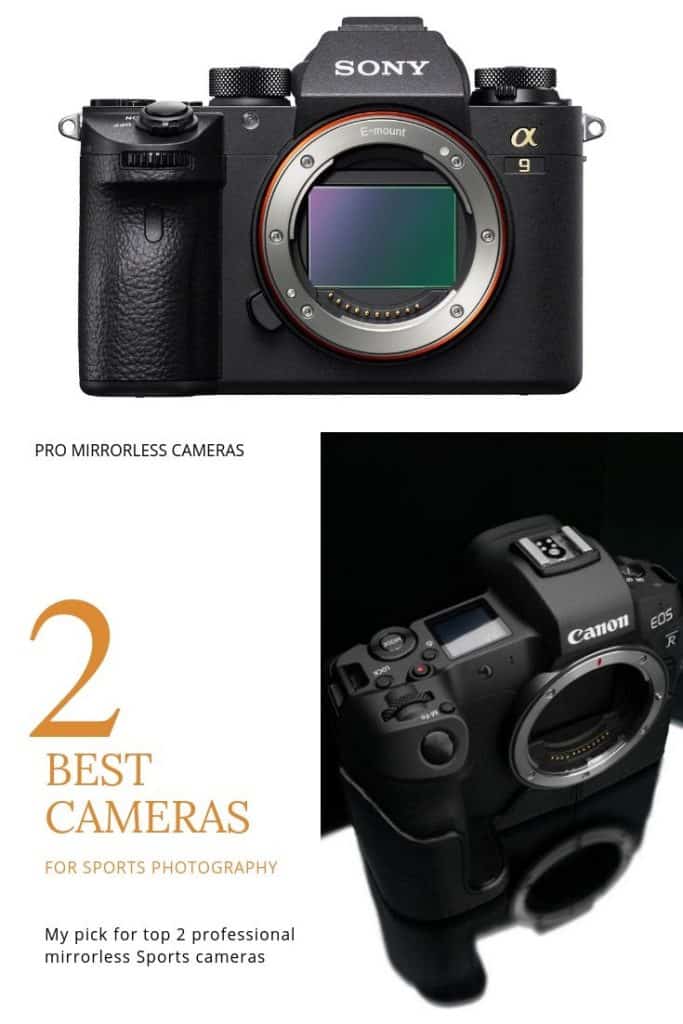
1. Sony A9
Sony specifically designed the A9 for sports photographer professionals. It has a special 24 megapixel sensor with extremely fast readout times which allow for advanced features like very reliable lock-on focus. It also has built-in stabilization, great depth of field control, excellent low-light performance and the only fast tele prime currently designed for mirrorless specifically (GE 400mm f/2.8 GM). The A9 currently blows all completion away.
- 20fps continuous shooting with AF/AE tracking
- 693-point focal-plane phase-detection AF
- Fast shutter release at 1/32000 sec., achieved silently
- Blackout-free shootingBlackout-free shootingUp to 480 frames on a single charge
- Up to 480 frames on a single charge
- FTP transfer via LAN terminal on the camera body
- Dual slots for convenient data management
- Silent shutter
- Full Frame Camera
- Resolution: 24 MP
- Max Video Quality: 4K 30fps
- Viewfinder: Built-In Viewfinder
- In-Body Stabilization: 5-Axis Optical
price: $3,498.00
2. Canon EOS R
Although Canon’s first full frame mirrorless camera did not make any big waves on release last year, Canon has improved many aspects of this camera with firmware updates. With a continuous shooting speed of 8fps (RP only has 5) and 5655 dual pixel AF points, this would be your best bet if you want to stick with Canon. The are no tele lenses or tele primes available for the moment, but you can adapt almost any older Canon lens and the adapters do work very well. There is no in-body sensor stabilisation though, and also only one SD card slot.
- RF Mount Compatible with RF Lenses and EF/EF-S Lenses (with optional Adapter)
- 30.3 Megapixel Full-frame CMOS Sensor and DIGIC 8 Image Processor.
- Dual Pixel CMOS AF with 5,655 Manually Selectable AF Points
- 4K 30p with Canon Log and 10 bit 4:2:2 HDMI Output
- Built-in EVF with 3.69 Million Dots
- Vari-angle Touchscreen LCD and Dot-matrix LCD Panel
- USB Charge Compatible.
- Silent Shutter
- Max Video Quality: 4K 30fps
price: $1,999.00
Other brands
At the moment, I would not recommend either Nikon or Panasonic full frame mirrorless cameras for professional sports photography since the autofocus is not fast enough for this type of shooting.
Best mirrorless camera for professionals: landscape
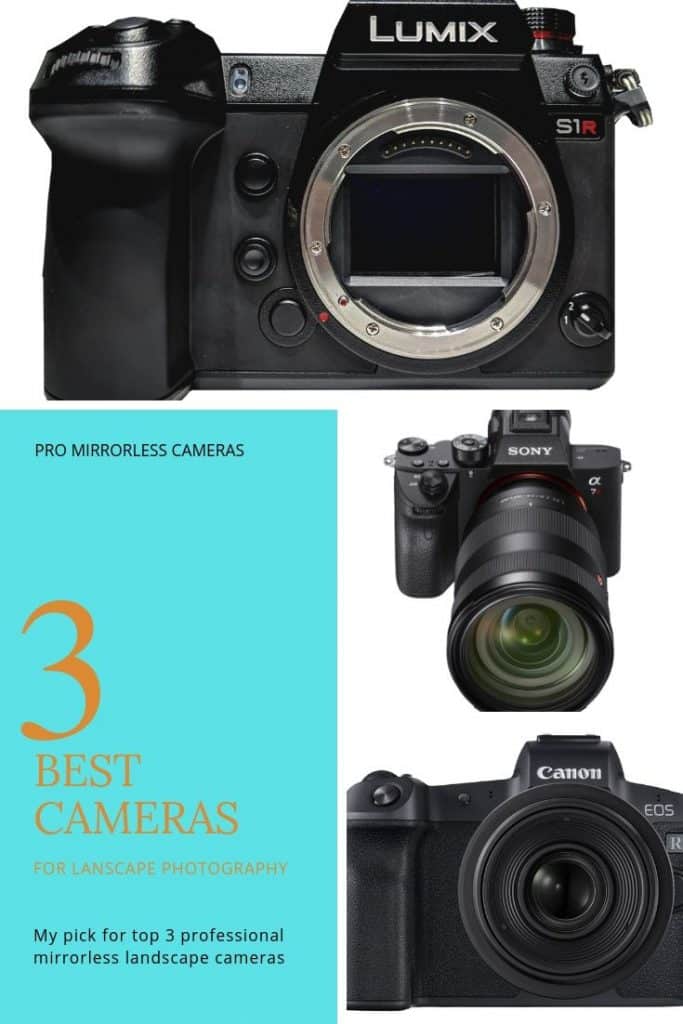
1. Panasonic S1r
The Panasonic S1R has a 47.3-megapixel CMOS full-frame image sensor, which is the highest megapixel full-frame sensor in a mirrorless camera to date. It also has something called Multi-Shot High-Res Mode that performs in-camera merging of 8 frames into single raw file with size equivalent to four frames. Meaning you’ll have extreme high resolution 200 MP full frame images to work with. Couple that with the soon to be released Lumix S 16-35mm f/4 lens and you’ll have a landscaper photographer’s dream. You could also use the Leica 16-35mm f/3.5-4.5 if you have deep pockets, or the Panasonic 24-105mm f/4 both of which are already available. The autofocus system is not as good as the competition by the way, but for landscape work, this should not bother you.
- 47.3-megapixel Full Frame sensor 4K UHD
- L-Mount Lens Compatible
- 4K 60p video (3840×2160) / 4K 24/30p Video (3840×2160)
- 5,760K OLED LVF, 9fps Burst, Advanced DFD + AI, 5 Axis Dual I.S 2 (6 Stops)
- 96MP High Resolution ModeMagnesium Body, Splash/Dust/Freeze resistant -10 C
- ISO range from 100 – 51,200
- In-Body Stabilization: 5-Axis Optica
Price: $3,697.99
2. Sony A7rIII
The Sony mirrorless system is frankly speaking the best out there for the moment. The A7rm3 is a very capable 42.2 MP camera used by many travel and landscape photographers today because it’s relatively small and portable. There are also several wide angle zoom as well as prime lenses available in all price classes from Sony, Zeiss and even Tamron. It’s also the most well rounded camera in this list with a very good autofocus system that’s capable of real time tracking and eye-af.
- 35mm Full-Frame 42.4 MP Back-Illuminated Exmor CMOS Senso
- Continuous Shooting at up to 10 fps
- 399 phase-detection AF points covering 68% of image area, 425 contrast AF points
- 5-axis optical in-body image stabilization with a 5.5 step shutter speed advantage
- High Resolution 4K Movie Shooting with full pixel readout and no pixel binning
- Resolution: 42 MPMax
- Video Quality: 4K 30fp
- In-Body Stabilization: 5-Axis Optical
price: $2,798.00
3. Nikon Z7
Another very capable camera for landscape work is the Nikon Z7. With it’s 45.7MP full frame sensor and very good weather sealing, you’ll be able to take it anywhere from the tropics to the North Pole. Nikon also just released the Nikkor Z 14-30mm f/4 S ultra-wide lens which would be an ideal lightweight travel combination for landscape work.
- 45.7 Megapixels full frame sensor
- 493 autofocus points
- 9 FPS Continous Shooting
- 64-25,600 ISO, Expandable to 204,800
- 4k UHD, 3840×2160 at 30/25/24p
- Max Video Quality: 4K 30fps
- In-Body Stabilization: 5-Axis Optical
price: $2,796.95
Best mirrorless camera for professionals: Portraits
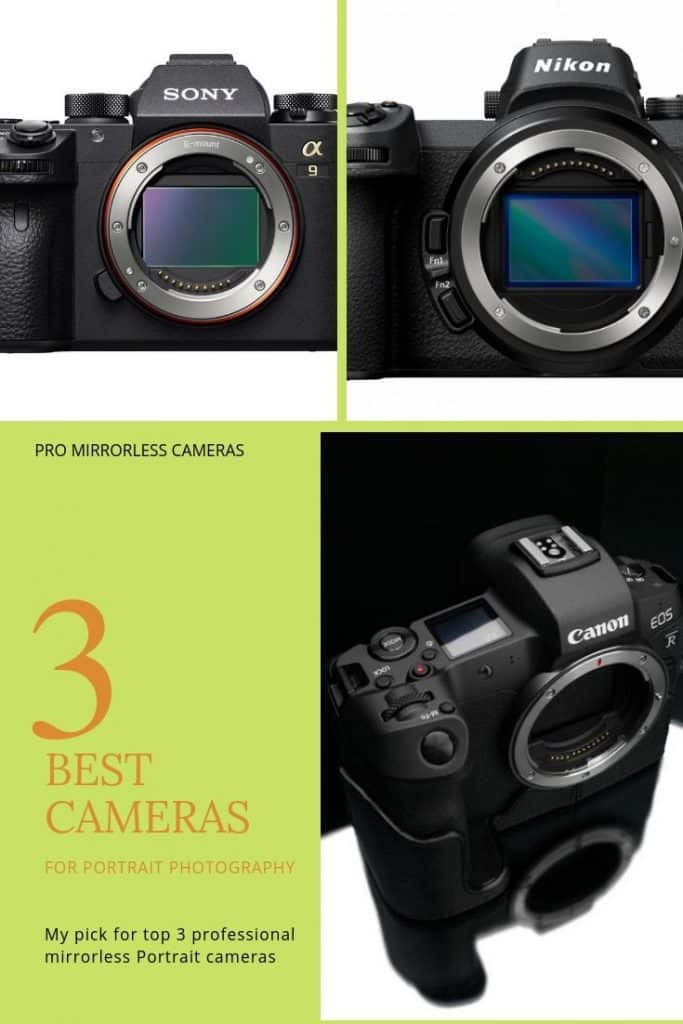
1. Sony A9
Many would have expected the Sony A7rm3 in first place I think, but my choice is the Sony A9. Simply because the Eye AF tracking since the latest firmware update 5.0 is simply amazing. Couple this camera with a sharp lens like the Sony 135mm f/1.8 GM and you have an extremely fast and accurate portrait photography camera. You can even select whether the camera will focus on the lot or right eye.
- 20fps continuous shooting with AF/AE tracking
- 693-point focal-plane phase-detection AF
- Fast shutter release at 1/32000 sec., achieved silently
- Blackout-free shootingBlackout-free shootingUp to 480 frames on a single charge
- Up to 480 frames on a single charge
- FTP transfer via LAN terminal on the camera body
- Dual slots for convenient data management
- Silent shutter
- Full Frame Camera
- Resolution: 24 MP
- Max Video Quality: 4K 30fps
- Viewfinder: Built-In Viewfinder
- In-Body Stabilization: 5-Axis Optical
price: $3,498.00
2. Nikon Z6
Firmware version 2.0 brought Eye Detection to the Nikon Z6 and although it’s not as good as the Sony a9 or A7III, it does make this camera quite useable for shallow depth of field photography with a fast prime like their Nikkor 50mm f/1.8.
- 24.5 Megapixels FX Format sensor
- 12 FPS Continous Shooting
- 100-51,200 ISO, Expandable to 204,800
- 4k UHD, 3840×2160 at 30/25/24p
- Max Video Quality: 4K 30fps
- In-Body Stabilization: 5-Axis Optical
price: $1,796.95
3. Canon EOS R
Yes, firmware update version 1.2 brought eye af to the Canon EOS R too, although it sits below Nikon’s implementation in terms of speed and accuracy. I prefer the slightly larger 30.3 MP sensor of the EOS R over the RP for portraits, it’s an excellent balance between resolution and speed. If you’re aCanon shooter, don’t worry, their next mirrorless camera release will fix this.
- RF Mount Compatible with RF Lenses and EF/EF-S Lenses (with optional Adapter)
- 30.3 Megapixel Full-frame CMOS Sensor and DIGIC 8 Image Processor.
- Dual Pixel CMOS AF with 5,655 Manually Selectable AF Points
- 4K 30p with Canon Log and 10 bit 4:2:2 HDMI Output
- Built-in EVF with 3.69 Million Dots
- Vari-angle Touchscreen LCD and Dot-matrix LCD Panel
- USB Charge Compatible.
- Silent Shutter
- Max Video Quality: 4K 30fps
price: $1,999.00
Best mirrorless camera for professionals: Weddings
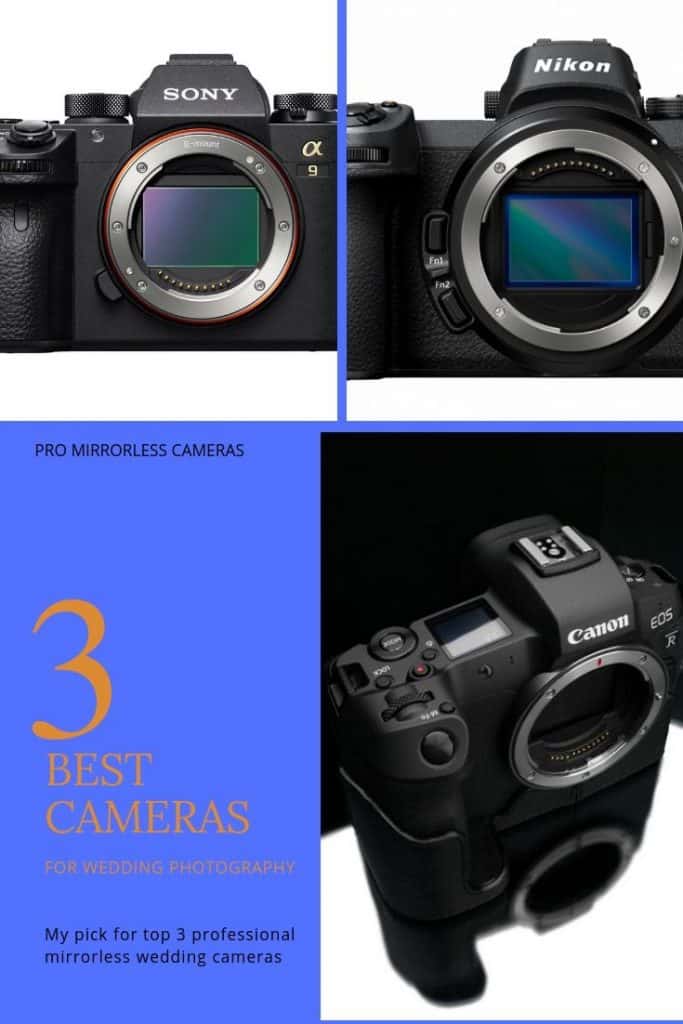
1. Sony A9
Also for wedding photography, the Sony A9 is the best full frame mirrorless camera. Focussing in low light down to minus 4 EV with an f/1.4 lens, this is about as good as you’ll find even in the best DSLR’s. The A7rIII is equally as light sensitive by the way, but focus will be less snappy so it’s best only used when you don’t absolutely need to capture that ring moment or kiss accurately. I find 24MP images a flexible and manageable size for wedding photography, switching perhaps only to a more megapixel camera for pre-wedding shots.
- 20fps continuous shooting with AF/AE tracking
- 693-point focal-plane phase-detection AF
- Fast shutter release at 1/32000 sec., achieved silently
- Blackout-free shootingBlackout-free shootingUp to 480 frames on a single charge
- Up to 480 frames on a single charge
- FTP transfer via LAN terminal on the camera body
- Dual slots for convenient data management
- Silent shutter
- Full Frame Camera
- Resolution: 24 MP
- Max Video Quality: 4K 30fps
- Viewfinder: Built-In Viewfinder
- In-Body Stabilization: 5-Axis Optical
price: $3,498.00
2. Nikon Z7
If you need more megapixels and you don’t mind a slower autofocus system, the Nikon Z7 is definitely worth your consideration for wedding photography. Although the Z7 is no slouch either with 492 hybrid AF (both phase and contrast) detection points and up to 9 frames per second shooting in continuous mode. The in-body sensor stabilisation coupled with excellent high ISO performance will allow you to get great indoor shots even in low light. It’s better in this regard than the A9 by the way, and now also has Eye AF since the last firmware update.
- 45.7 Megapixels full frame sensor
- 493 autofocus points
- 9 FPS Continous Shooting
- 64-25,600 ISO, Expandable to 204,800
- 4k UHD, 3840×2160 at 30/25/24p
- Max Video Quality: 4K 30fps
- In-Body Stabilization: 5-Axis Optical
3. Canon EOS R
Even though Canon hasn’t exactly pulled out all the stops yet with their first ventures into the mirrorless market, the EOS R is still a very capable camera for weddings too. The latest updates have really improved both accuracy and speed of autofocus.A pity that the sensor does not perform as well as it’s rivals, but you won’t notice that unless you compare them side by side.
- RF Mount Compatible with RF Lenses and EF/EF-S Lenses (with optional Adapter)
- 30.3 Megapixel Full-frame CMOS Sensor and DIGIC 8 Image Processor.
- Dual Pixel CMOS AF with 5,655 Manually Selectable AF Points
- 4K 30p with Canon Log and 10 bit 4:2:2 HDMI Output
- Built-in EVF with 3.69 Million Dots
- Vari-angle Touchscreen LCD and Dot-matrix LCD Panel
- USB Charge Compatible.
- Silent Shutter
- Max Video Quality: 4K 30fps
price: $1,999.00
Best”cheap” full frame mirrorless
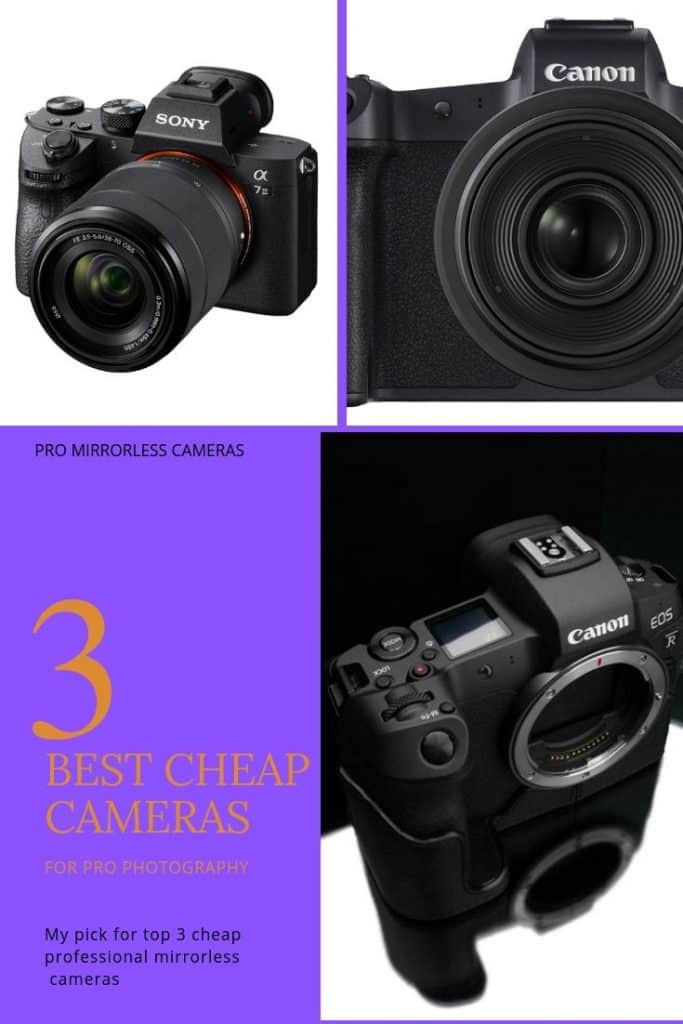
1. Sony A7 III
Despite what the guy in the camera store says, don’t buy a Sony A7 series camera below the Mark 3. This was the turning point for Sony mirrorless when it became a mature system, and when they lowered prices in response the the full frame mirrorless competition. The A7 III has most of the things that make the A9 so great, at a greatly discounted price. Since the latest firmware version, it even has Eye AF as well as Animal Eye autofocus detection for under $2000.
- Advanced 24.2MP Back-Illuminated 35mm Full-frame sensor
- 15-stop dynamic range,
- 14-bit uncompressed RAW,
- ISO 50 to 204,800
- Up to 10fps Silent or Mechanical Shutter with AE/AF tracking
- 693 phase-detection / 425 contrast AF points w/ 93% image coverage
- Eye-AF with AF-C
- touch AF
- 4K HDR3 Movie w/ full pixel readout, no pixel binning or crop
- USB Type-C (USB 3.1 Gen 1 compatible) and Micro USB
- Camera Resolution: 24 MPMax
- Video Quality: 4K 30fps
- In-Body Stabilization: 5-Axis Optical
Price $1,998.00
2. Canon EOS RP
Just to show how serious Canon is about the mirrorless market, they released the EOS RP. It has 4779 AF and also features Canon’s proprietary Dual Pixel AF technology with pupil detection for a price around $1500! Specs wise, it sits slightly below the A7II but we can’t complain at this price.
- RF Mount Compatible with RF Lenses and EF/EF-S Lenses (Optional Mount Adapter EF-EOS R)
- 26.2 Megapixel Full-frame CMOS Sensor and DIGIC 8 Image Processor
- Dual Pixel CMOS AF for Fast and Accurate Auto Focus
- Built-in EVF with 2.36 Million Dots
- Touch & Drag AF
- Vari-angle Touchscreen LCD
Price: $1,299.00
3. Canon EOS R
The Canon EOS R should also be included here as it’s now less that $2000. A lot of bang for your buck here, especially when you’ve already invested heavily in Canon EF lenses. Canon in also a very well established brand that is still selling the most units in the world, so you know the are not going anywhere.
- RF Mount Compatible with RF Lenses and EF/EF-S Lenses (with optional Adapter)
- 30.3 Megapixel Full-frame CMOS Sensor and DIGIC 8 Image Processor.
- Dual Pixel CMOS AF with 5,655 Manually Selectable AF Points
- 4K 30p with Canon Log and 10 bit 4:2:2 HDMI Output
- Built-in EVF with 3.69 Million Dots
- Vari-angle Touchscreen LCD and Dot-matrix LCD Panel
- USB Charge Compatible.
- Silent Shutter
- Max Video Quality: 4K 30fps
Best mirrorless camera for professionals conclusion
Which mirrorless camera is best for a professional photographer will depend on your specific needs. It’s clear however that Sony has gained the most knowledge in the last decade when ift comes to hardware, software and autofocus algoritmns. It’s an innovation that can only be implemented thanks to the principle of the sensor always being powered and on-sensor autofocus points, with the summum being the Sony A9 and the cheaper A7III.
I would think that in the future Canon would at least have second place in the mirrorless market thanks to the large Canon DSLR user base as well as their large budgets for R&D. For now, most photographers are not that impressed due to some big ommisons in the design like no sensor stabilisation and only one SD slot. It’s however a great option to get an EOS R or RP as a second body next to your professional DSLR.
Nikon has made two beautiful and complete mirrorless bodies with the Z6 and Z7. Autofocus is unfortunately somewhat of a weak point in both bodies, and the lack of specially designed mirrorless lenses makes it a less desirable option to start your mirrorless journey. They are also at the moment more expensive than the competition.
Finally, Sigma and Panasonic will have a lot of catching up to do in the next few years if they want to compete in the full-frame mirrorless marken. Although the Panasonic S1 and S1r do look promising on paper, the autofocus capabilities are the worst of what’s available today, and this at a similar price. Autofocus is of course less important for a lanscape and architecture photographer to whom I would potentially recommend the Panasonic S1r.
Have you made your choice? And why? Let me know in the comments.


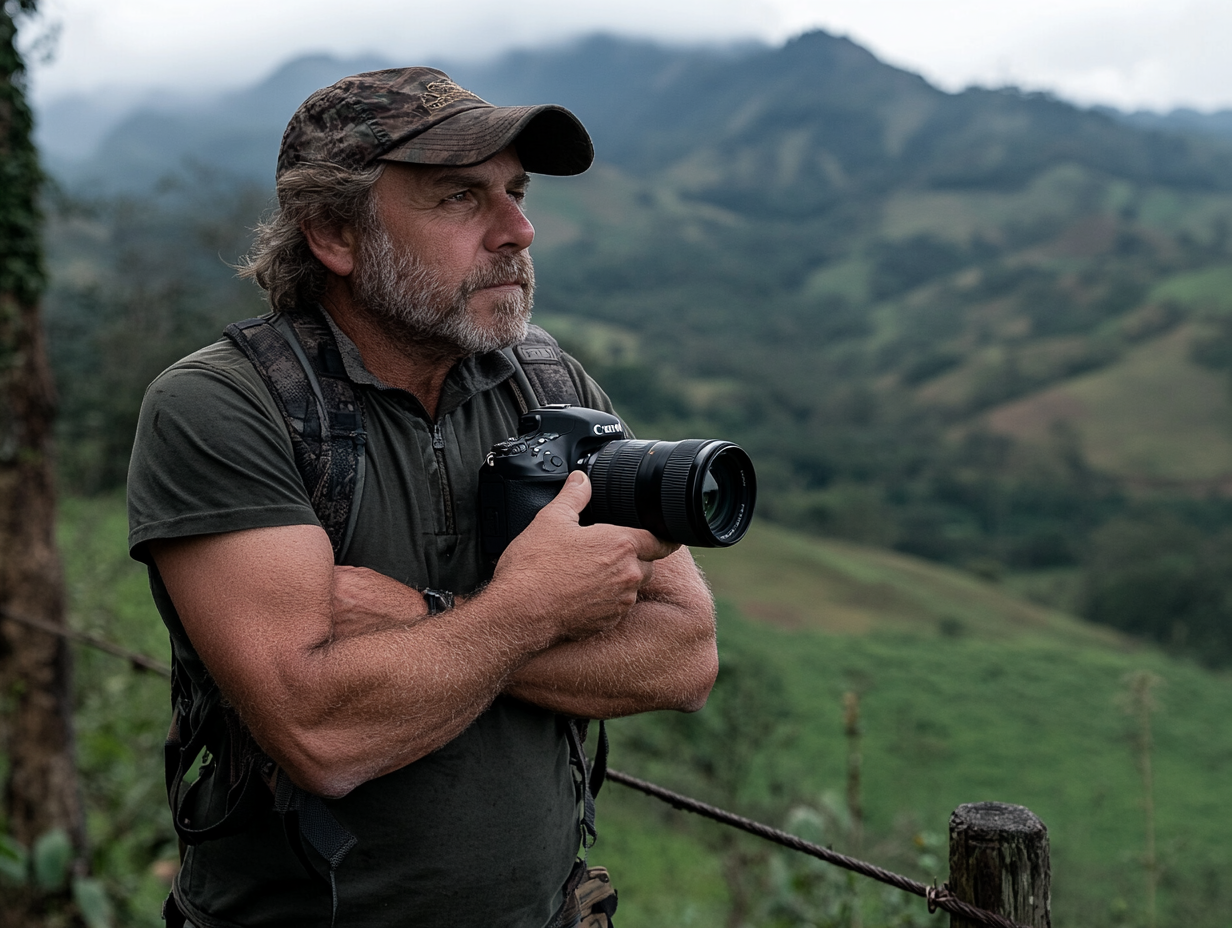
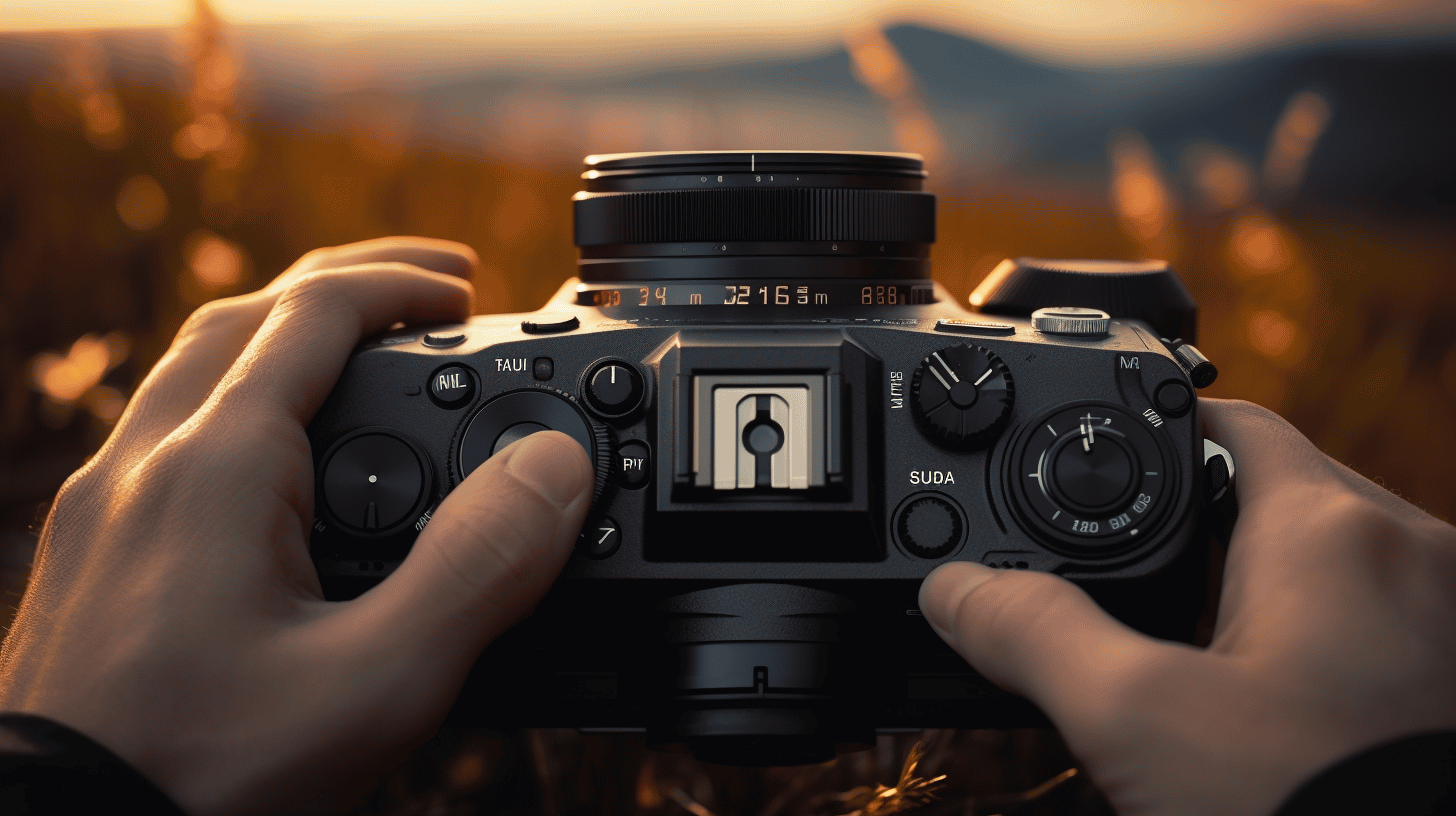
Hi,
I am a travel and landscape photographer with two kits :
-Canon 5D2 with 17-40f4, 24-105f4 IS, 50f1.8, 40f2.8, 100f2.8 macro, mpe65f2.8 macro, TSE-24, Zeiss Macro 50f2, flash macro mtx-24, flash 580
-Fuji XT1 with the 18f2 and the 35f1.4.
I like the fuji kit for its evf, size and weight but I prefer the image quality from my canon. Since 6 years I concentrate more on travel and landscape photography and bring with me only 3 lenses 24-105, 24tse, zeiss 50f2. Also i love to do video with my gopro kit and want to add more scene from my main camera.
I want to buy a new mirrorless camera because I prefere to work with the evf. I have tried the sony a73 but I don’t like their ergonomic, color and evf. I have tried the EOS R but I am disappointed by the ergonomic (no joystick, touchbar). Finally I tried the Panasonic S1 and love their evf and ergonomic. But for the lens I prefere canon with their future 24-70f2.8 and 70-200f2.8. If i buy the Panasonic s1, I will need to bought their 24-105 and an adapter. The mc21 adapter don’t work well with some lens.
It’s difficult to have full resolution of S1 sample in jpeg or raw to conclude something about the image quality. If you have larger resolution it will be apreciate.
Sorry for the long story but i ask you what’s your recommandations?
Thanks in advance.
Hi Yvan,
Since you already own a Canon, it would make sense to stick with that brand. You can adapt your lenses too for the moment, and they will be in business and producing mirrorless cameras for a long, long time.